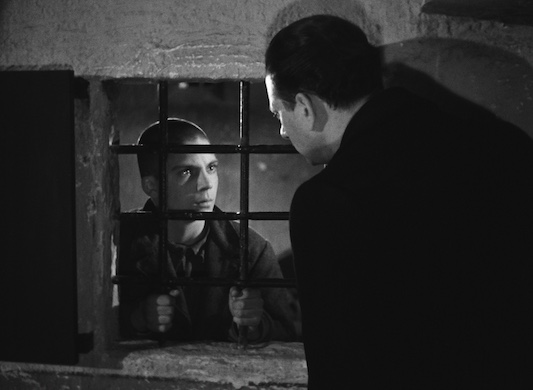Orson Welles Was Impressed by ‘Shoeshine,’ but It Is Not Even Director Vittorio De Sica’s Finest Film
While ‘Shoeshine’ stands in the shadow of ‘Bicycle Thieves’ (1948) and ‘Umberto D.’ (1952), by general consensus the finest of De Sica’s neorealist efforts, it does have its adherents.

‘Vittorio De Sica’s “Shoeshine”’
Film Forum
June 14-27
“What [Vittorio] De Sica can do, I can’t do …,” Orson Welles averred after watching “Shoeshine” (1946): “the camera disappeared, the screen disappeared; it was just life.” What Welles couldn’t do, in this case, was allow himself the freedom — a kind of trust, really — to allow events to unfold before the camera with a minimum of cinematic derring-do. This was neorealismo and its tenets could not have been further from the Hollywood norm or, for that matter, the prerogatives of Welles’s ego.
Which isn’t to say that “Shoeshine,” which will be undergoing a two-week revival at Film Forum, is free of calculation. Neorealism was the Italian response to the deprivations of World War II. Cities had been reduced to rubble and the economy was troubled. With its infrastructure compromised, the Italian film industry couldn’t help but respond with a concomitant humility. An influential cadre of filmmakers sought to bring their metier back to basics.
They did so by shooting on location, working with nonprofessional actors, and telling stories predicated on the hardscrabble lives of ordinary people. Luchino Visconti’s “Ossessione” (1943), a riff on James M. Cain’s novel “The Postman Always Rings Twice,” is often cited as the first neorealist film for its unpicturesque take on the highways, byways, and landscape of Italy. Roberto Rossellini’s “Rome, Open City” (1945) would go on to make a splash internationally, not least because it embodied the post-war realities of the “Italian Spring.”
De Sica was among the primary adherents of neorealism. He began his career as an actor, working on the stage and establishing his own theater company at age 22. A deft hand at comedy, De Sica proved his mettle as a dramatic actor as well. He earned an Oscar nomination for Best Supporting Actor in the otherwise forgettable “A Farewell to Arms” (1957), but achieved immortality for a bravura turn as the suave Baron Fabrizio Donati in Max Ophüls’s “The Earrings of Madame de … ” (1953). Actually, De Sica has a lot of immortality chits on his CV, especially as a director.

While “Shoeshine” stands in the shadow of “Bicycle Thieves” (1948) and “Umberto D.” (1952), by general consensus the finest of De Sica’s neorealist efforts, it does have its adherents. Pegging it as “one of the greatest and most famous films of all time,” a critic for the New Yorker, Pauline Kael, went on to ask “if people cannot feel Shoeshine, what can they feel?” James Agee, in a contemporaneous review, stated that De Sica created “an awareness of the pitiful complexity of the causes of even simple evil.” The Academy of Motion Pictures Arts and Sciences bestowed “Shoeshine” with the first award for Best International Feature Film.
The picture centers on two friends, the adolescent Pasquale (Franco Interlenghi) and the slightly younger Giuseppe (Rinaldo Smordoni). They make a meager living shining shoes — mostly, it seems, of American G.I.’s. Their dream is to purchase a horse, but not just any horse: They have their eyes on the swift and handsome Bersagliere. The asking price is high, as are the costs to keep the horse, but when Giuseppe’s older brother Attilio (a smarmy Annielo Mele) offers the boys a lucrative job fencing contraband, our heroes can’t resist. Bersagliere may be within their grasp.
The transaction doesn’t go quite as planned — due, largely, to Attilio’s scheming — but Pasquale and Giuseppe manage to bank the funds to buy Bersagliere. Just as their dream is realized, the boys are hauled in by the police, accused of theft, and summarily placed into juvenile detention. Their loyalty, both to family and each other, is put to the test as the adults-in-charge play fast-and-loose with protocol. They extract information from Pasquale through bogus means. Giuseppe, who’s been separated from his friend, attempts a prison break with a new batch of cronies.
The two friends are ultimately reunited, with each other and Bersagliere, but, remember, this is neorealism: Much as endings in real life don’t come with a guarantee of happiness, so it is with “Shoeshine.” Yet, on the whole, the film is less realistic than — well, “fanciful” isn’t the right word, but fantasy does enter into it. Notwithstanding cinematographer Anchisi Brizzi’s emphasis on grit and dirt, he simultaneously suffuses the proceedings with a fairytale-like aura, a romantic haze that diminishes the story’s realismo. It doesn’t help that the prison warders, gargoyles almost to a man, are cartoonish in appearance and performance.
There is, in other words, a reason “Shoeshine” doesn’t survive as a primary exemplar of neorealism: The injustices it seeks to underline are too self-evidently moralistic and its characters less flesh-and-blood than points on a graph. De Sica’s way with children, all of whom were non-professional actors, is where the film thrives: Their unaffectedness grounds the movie in exactly the manner in which the neorealists intended. But the couching of their story is — well, it’s something Welles could have done. “Shoeshine” is a fine film, but there are better places to start with De Sica.

